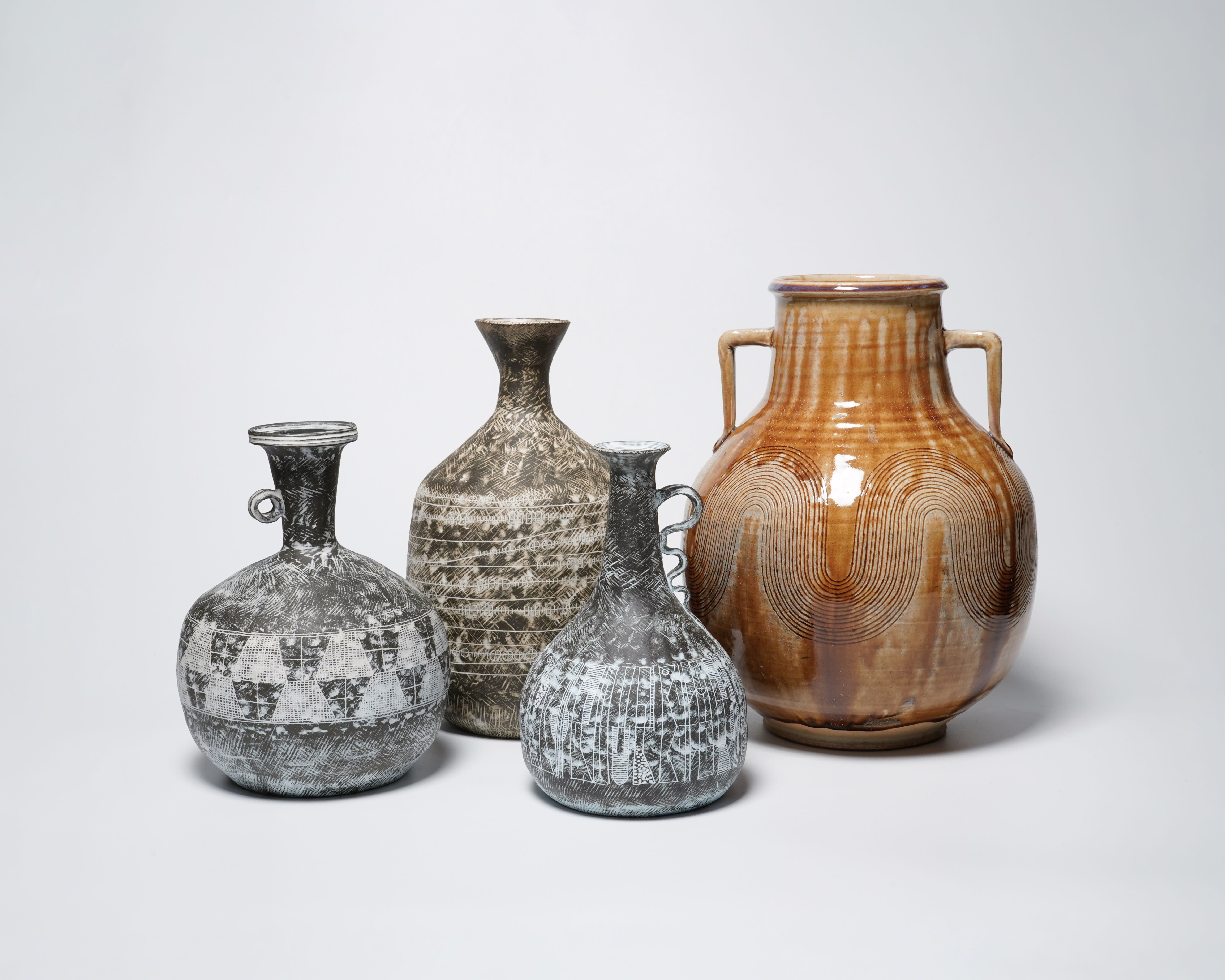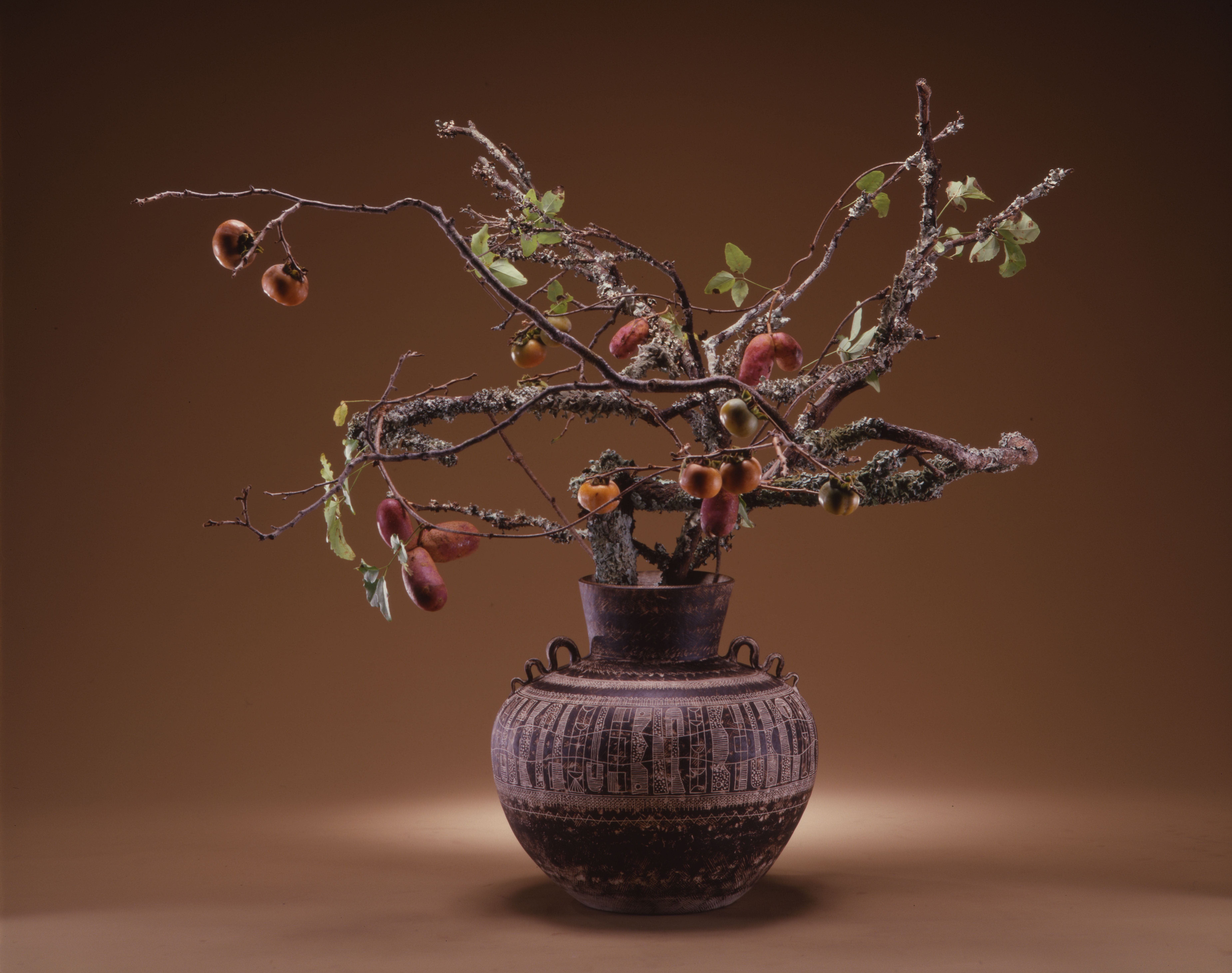
In 1993, the Meguro Art Museum in Tokyo held a retrospective for the ceramicist Yasuhara Kimei, today also known as Yasuhara Yoshikai. The exhibition, “Poet of the soil: Ancient verse, modern form”, presented the extraordinary artistic journey of one of the most significant ceramicists of the twentieth century. As its accompanying exhibition catalogue made clear, Yasuhara Kimei was a prodigious talent, an artist whose ceramics embodied and transcended the dramatic artistic and social-political shifts in Japan during his lifetime. In the Kanto region and beyond, his contributions to the ceramics culture are held in the highest regard and yet he remains largely unappreciated in the English-speaking world.
Today, Yasuhara is most readily recognised for his high-fired vases, which are matte grey-black in colour and featuring intricate, inscribed designs filled with white slip. To create these works, Yasuhara used a combination of red Seto and Shigaraki clays, which when mixed with ground feldspar, iron oxide and cobalt, produce a distinctive dark surface. Yasuhara utilized a diversity of tools to create his unique designs including, bamboo spatulas, nails, saws and stamps. The techniques applied to create these vessels and the artistic vocabulary displayed on many of the works shown in this catalogue and exhibition are emblematic of the myriad influences on early twentieth-century Japanese ceramicists, who strived to define themselves as individual artists and ceramics as a path for personal expression. Like his contemporaries, Yasuhara was inspired by the technical virtuosity and unique surface decoration of historical ceramics created in China and Korea, as well as contemporaneous European artists.
An overview of his career reveals an artist with great creative capacity, a ceramicist whose vessels, no matter how transgressive and sculptural, remained receptive, literally, for use in the art of flower arrangement (Ikebana). Over time, his practice shifted from lustrously glazed vessels to tubular constructions and ceramics for everyday use, often with striking conceptual titles referencing the body and the phenomena of the world. Yasuhara Kimei was both an artist of his time and an artist of his own mind, an individual whose journey requires reassessment and reconsideration.
To appreciate Yasuhara’s career, it is important to understand the place where he spent the majority of his life – the Meguro ward of Tokyo. Around the time of his birth, in 1906, Tokyo was undergoing transformation from a feudal society to a modern nation, and by the time of his death in 1980 it had become a high-tech hub of a globalised world.

Yasuhara was born in the last years of the Meiji era (1868–1912), a period when the great masters of export ceramics achieved a technical virtuosity never seen before or since. The government invested heavily in the ceramics industry, also establishing the Imperial Museum (present-day Tokyo National Museum) in 1889 and universities to foster the next generation of ceramicists. Modern masters like Tomimoto Kenkichi (1886–1963) attended the Tokyo School of Fine Arts (present-day Tokyo National University of Fine Arts and Music), while others such as Hamada Shōji (1894–1978) and Kawai Kanjiro (1890–1966) attended the Tokyo Industrial High School (Tokyo Kogyo Koto Gakkō).
The modern ceramics culture that emerged in Tokyo during the Taisho era (1912–26) was fostered by highly trained ceramicists, well versed in the history of ceramics, particularly East Asian ceramics, and influenced by the British Arts and Crafts movement and modernist European sculpture and painting. One of the defining features of modern Japanese ceramics was the emphasis placed on individual expressions of artistic creativity, achieved through mastery of technique and form. The hand of the artist was essential to this process (jitsuzai shugisha), as opposed to ceramics made to order or created by assistants. Modern pioneers such as Tomimoto Kenkichi, Kusube Yaichi (1897–1984), and Yagi Issō (1894–1973) signed, named and exhibited one-of-a-kind vessels and lobbied to have art ceramics (bijutsu toki) classified as fine art.
As the middle class expanded and sought out new modern expressions in clay, department stores became sites for exhibitions of the most avant-garde ceramics and engagement in pertinent discussions. Yanagi Muneyoshi (1889–1961) elicited a renewed interest in Korean ceramics at his Korean Folk Art exhibition, held in 1921 at the Ruisseau Gallery (Ruisō) Gallery in Kanda, Tokyo. Yanagi was central to establishing the tenets of the Folk Craft (Mingei) movement, along with Hamada Shōji, and pursued an alternative model, one that prized the spiritual qualities in Japanese folk-craft created by nameless craftsmen. This ultimately resulted in the establishment of the community at Mashiko in 1923.
In 1918, Yasuhara left junior high school and began training with one of the most revered ceramicists of the twentieth century, Itaya Hazan (1872–1963), who at the time was known for adopting the Western style of art nouveau and integrating Japanese and Chinese ceramic forms into his work. During the first quarter of the twentieth century, Itaya Hazan played a critical role in transforming Japanese ceramics from a craft made by anonymous artisans into a fine art, worthy of a newfound respect. In common with Itaya, Yasuhara was not born to a prestigious ceramic lineage and, like him, became dedicated to both form and surface of his vessels. Itaya’s background as an art historian with a focus on sculpture may have inspired his attention to the surface of his vessels which are often deeply inscribed or feature relief with matte glazes.
Itaya’s displeasure with the official exhibitions of Japanese design and applied arts known as Noten, sponsored by the Ministry of Agriculture and Commerce in 1913, led eventually to the founding of the Society of Eastern Potters (Totokai) in 1927, along with sculptor Numata Kazumasa (Ichiga) (1873–1954). Their shared goal was to position ceramics as a fine art. Yasuhara was involved in its establishment, and participated in the first exhibition, held at the Nihonbashi branch of the Mitsukoshi department store in 1931. Throughout his life he participated in these exhibitions, with his works still presented – along with those of Itaya – as an essential component of the Totokai lineage. The importance of this group cannot be overstated, as its actions ultimately induced the Imperial Art Academy (Teiten) to establish the category of ‘arts crafts’ (bijutsu kogei) at the national salon (Teiten/Nitten) in 1927, which for the first-time placed ceramics on the same level as painting and sculpture.

In 1928 Yasuhara opened a kiln at his home in Meguro, developing works centred on stoneware characterised by abstract and geometric designs, and in 1930 he won first prize at the eleventh iteration of the Teiten. Yasuhara’s avant-garde ceramic vessels came to the attention of Teshigahara Sōfū (1900–1979), a leading proponent of zen ei ikebana and founder of the progressive Sōgetsu School (Sōgetsu ryū). Teshigahara was seeking vessels to complement his unorthodox and free-flowing flower arrangements, and Yasuhara’s uncompromising grey vessels and unique forms provided a perfect foil for his modern ikebana. Teshigahara encouraged Yasuhara – and other ceramic artists – to create non-traditional works difficult to use for flower arrangement.
Throughout his career Yasuhara was a regular contributor to national exhibitions of first the Bunten and later Nitten. In the post-war years his ceramics were exhibited across the world, including in exhibitions throughout Europe. Yet, his work and influence remain unappreciated. It is my hope that this catalogue and exhibition will change that.
